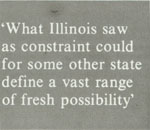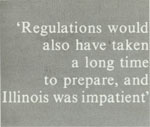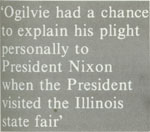
Illinois succeeded in getting the crucial HEW memorandum. Sent to federal regional officials, it resulted in overturning the policy that federal public assistance funds should not pay for activities normally the responsibility of other state agencies. 'In the context of the Illinois demands, the memorandum seemed a compromise and an instance of drawing lines where none had been drawn before'
Copyright® 1975 by The Brookings Institution, Washington, D.C.
ILLINOIS opened the way in 1971 for
higher federal support of public aid programs through its bold interpretation of
federal regulations on the purchase of
services from other state agencies. Trading
on its party affiliation with President
Richard Nixon, the administration of
Richard B. Ogilvie succeeded in fully
exploiting the loopholes of the federal laws
and regulations in a confrontation with the
federal Office of Management and Budget.
The first installment appeared in the
April magazine.
The June 17 memorandum repudiated the old BFSą policy that purchase
should not be used to pay for activities
that are normally the responsibility of
other state agencies. This new interpretation relied heavily on a phrase in the
Social Security Act dating from 1956,
which stipulates that state plans should
describe services given to assistance
recipients and the steps taken to assure
"maximum utilization" of other agencies. This language, which was enacted
before federal matching of purchase had
been authorized, now was used to justify
a very broad interpretation of the
permissible scope of purchase. Citing
"programmatic developments" as well
as changes in the statute, the memorandum stated: Purchase of services [from other public
agencies] now provides a meaningful alternative to the furnishing of services directly
by staff of the State or local agency. The broad definitions of social services
[following the 1962 and 1967 amendments]
inevitably lead to inclusion of activities
which have previously been considered the
province only of other agencies .... The
development of comprehensive services has
combined what were formerly the interest of
several agencies, and no agency can claim an
exclusive franchise on the product. When
such activities are carried out in the community, the State or local agency should
properly assume its share of financial
support, even though another agency
actually provides the service. All the public
agencies must be increasingly responsive to
the needs of the poor and the community as a
whole .... In this context, "maximum utilization" of
other agencies . . . must be construed flexibly and realistically in the light of today's
situation. A policy that federal public assistance
funds should not pay for activities that
are normally the responsibility of other
state agencies had finally been turned
upside down. They should be so used,
when public services are being offered to
poor people. This was what Joe2 had
said in his paper for the American Public Welfare Association in 1968 and
what he had been saying to state and local officials, but it had not emerged as
explicit SRS3 policy before June 17.*
Only two broad kinds of state social
services were excluded. One was public
education. The memorandum said it
would not be appropriate to use federal
social services funds to pay for the
regular school costs of public assistance
recipients. It said also that institutional
care of the mentally ill remained entirely
a state and local responsibility. However, that did not rule out financing new
or additional social services in public
schools or mental hospitals. Some
sources in the SRS recalled that in
preceding months Joe had indicated a
wish to go further with federal support
of institutional care, and they surmised
that at this point Cohen4 drew a line. 1 Bureau of Family Services of U.S. Department of Health, Education and Welfare (HEW)
2 Tom Joe, an appointed, policy-level official of HEW
3 Social and Rehabilitation Services of HEW
4 Joel Cohen, assistant general counsel for SRS * The steps in this evolution were from explicit prohibit ion (I 9621
to silence (1969) to an explicit statement of obligation. The 1969
SRS regulations sanctioned a wide-ranging use of funds The
preliminary version appearing in the Federal Register in July 1968
said that the SRS "encourages Stales to view Title IV-A as the vehicle for providing a lull range of services to those families needing services who are on AFUC rolls as well as necessary
services to families who have been or are likely to become eligible
for AUK. (Vol. 33. no. 138. July 17, 1968, p. 10235.) But even
this language encouraging as it was in regard to purchases oil
behalf of eligible families, stopped short of saying that the public
assistance program ought, through purchase. to pick up -some share
of the cost of activities hitherto the responsibility of other public
18 / May 1977 / Illinois Issues
There was a history of contrary action by Congress. The memorandum pointed out that Congress had repeatedly declined to provide public assistance funds for mental, correctional, or children's institutions.
| Joe, it is safe to say, could be confident that the policy he stated was one that Under Secretary Veneman approved, though neither man recalls that Veneman did approve the actual document. "If I didn't clear it," Veneman later said, "Tom did it with the assumption that I would approve" — and that was "a fair assumption." Veneman explained that "Tom knew pretty much where I was on this, we talked so often." Veneman talked often, too, with governors who were interested in service grants; by all accounts, he was keenly sensitive to the political elements of grant-in-aid administration. He favored making federal services grants available for broad purposes (as long, so he later said, as they were used to expand state programs), and within the department his views were likely to be conclusive, for Secretary Richardson left welfare very much to him unless major new legislation was involved. Social security, social services. Medicare, Medicaid — all these were principally "Veneman's bag," an aid to Richardson recalled. |

|
Cohen deferred to political leadership; both he and Joe understood that Joe would be responsible for the contents of the June 17 memorandum. Typically, an HEW lawyer eschews "making policy" but advises the appointive agency head whether the policy he proposes is proscribed by law; he identifies the range of the policymaker's discretion. In this case, the proscriptions of the law were few, the range of permissible discretion was enormous, and the social context of policy making had changed a great deal in a short time. Therefore Cohen as assistant general counsel could with a perfectly clear conscience sign off on policies in 1969 or 1971 that were very different from those of a few years before. That he had so active a part in preparing this particular memorandum, a document not much distinguished by a lawyer's precision, is itself anomalous and is partly to be accounted for by the default in the SRS, which for some time had been trying unsuccessfully to come up with new policies on social services. Twiname6 did not seize the issues, posed by Illinois, and the CSA7 was immobilized by a lack of both leadership and experienced staff, as well as by the air of high politics that hung over the case. Joe, who disdained bureaucratic channels and who had made social services his business for some time, stepped in or was drawn in and then drew Cohen in too — informally, as Cohen thought of it, rather than officially as assistant general counsel. Impressed into service at Joe's request and mindful of Joe's blindness, which required working in tandem on such matters, Cohen became on the spur of the moment the drafter of a policy document rather than a lawyer independently advising his client, although he reserved the right to raise legal questions. The draft that he wrote mixed Joe's language with what Cohen understood to be Twiname's policy preferences and what he presumed to be codification of actual administrative practice.
The authors of the June 17 memorandum did not regard it as a wholesale concession. In truth, no one at headquarters knew just how much of a concession it might be, because no one there knew precisely what the regional offices had been approving for inclusion in state plans. Illinois officials, on the other hand, seemed to know, and made clear that they expected approval for anything anyone else had done or planned to do. The memorandum did mix constraints with the concessions, and the mix could vary from state to state. What Illinois saw as constraint could for some other state define a vast range of fresh possibility. In the context of the Illinois demands, the memorandum seemed a compromise and an instance of drawing lines where none had been drawn before. Besides drawing the line at certain types of expenditures desired by the state (Illinois, after all, was much interested in matching institutional expenses, and in negotiations it had begun to advance claims for education), the memorandum reasserted the single-state-agency principle: the state public assistance agency "must remain as the point of responsibility for all activities under the program," including determinations of individual eligibility and the provision of purchased services. The memorandum applied only to situations in which the state agency purchased services with funds directly appropriated; it explicitly declined to discuss the use of state funds, other than public assistance appropriations, as the state matching share of services costs. Noting that federal regulations required an agreement between the state public assistance agency and the service provider, the memorandum stipulated that "Federal matching in costs is available only from the point at which the agreement is in effect and services under it are delivered to eligible clientele." These provisions could have constituted defenses against the Illinois claims had policy-level officials been determined on defense. Finally, the memorandum provided that federal funds should not
5 Health, Education and Welfare, U.S. Department of. 6 John Twiname, an appointed, policy-level official of HEW 7 Community Services Administration of HEW
May 1977 / Illinois Issues / 19
be used "merely to replace State and local funds." They should "result in a significantly expanded amount of public services for poor people," a provision that Joe would later insist was the crux of the memorandum and a significant new assertion of federal control. Cohen wanted to require expansion of service in strict proportion to the increase of federal funds, but Joe thought that was too harsh.
| In all, this memorandum was an extraordinary public document. In content, it was high policy. Basic principles of public assistance administration and possibly hundreds of millions of dollars in federal funds were at stake. In form, however, it was treated as less than policy. This was a memorandum of "clarification," not a regulation; thus Twiname's office did not put it through the elaborate process of review and clearance that is used for regulations. It was not cleared with the HEW comptroller or with the secretary. It was not addressed to state governments but to federal regional officials "as a basis for negotiations with State agencies and evaluation of State plans." And it was signed by a man who had ceased to hold office. |

|
Naturally, SRS regional officials were puzzled by this document and asked guidance on what to do with it. The reply from headquarters in July surpassed the original in equivocation. A memorandum from Commissioner Bax8 explained that state officials were generally aware of the contents, since Twiname had discussed the June 17 memorandum at a meeting of the Council of State Public Welfare Administrators, but that headquarters did not "intend to publish the statement or issue it formally to State agencies at this time . .. it is a flexible document, subject to such change as may prove to be necessary." Bax then proceeded to add: "1 urge you to share the content of this statement with the States. However, if you distribute copies of the actual statement, they should be clearly marked DRAFT." Draft or not, the regional offices were instructed to use the memorandum as "guidance material" in assisting the states in program development.
Alone among the principals, Cohen appears to have doubted whether this document should be distributed at all. Besides being highly irregular in form, it ran the risk of stimulating demand. On the other hand, Cohen shared with Joe and Twiname a concern that the SRS should issue something. Illinois and other states were opening up new questions, discrepancies among states and federal administrative regions were growing, and the SRS needed to interpret the regulations, which were proving inadequate. Moreover, it was hard to argue that if this were guidance for the case of Illinois, it should not be guidance in other cases too. If the memorandum did stimulate demand, both Joe and Twiname were wholly willing to accept that result, although they did not foresee quite the explosion that was to occur. For the issuance to be informal and to be signed by the outgoing, relatively low-ranking Simonds9 was thought to minimize the risks; if necessary, the SRS could recant, whereas regulations would have been nearly immutable. Regulations would also have taken a long time to prepare, and Illinois was impatient.
For his part, Simonds thought that clarification of SRS policy and further encouragement to the states were desirable. He had been contemplating some such initiative himself, he later said. In his recollection, and his alone, his office played a large part in drafting the document. He did not think of the memorandum as a response to any particular state, and, indeed, he appears to have been unaware of the intense pressures from Illinois, which were directed at higher offices than his.
Equivocal as it was — or as its sponsors wished it to be — the memorandum made crucial concessions to Illinois. Though they professed disappointment at the time, Illinois officials were "very gratified," as one later acknowledged. After June 17, it would have been difficult for HEW to reject the Illinois plan proposals. Yet approvals did not immediately follow. Ostensibly a clarification, the memorandum still left much to interpretation, especially as to whether federal funds would supplant state funds. Negotiations went on.
As the end of September approached Illinois pressed for a decision. The SRS could not delay forever, and September 30 was a deadline in the eyes of state officials who believed that Illinois would lose the right to certain retroactive federal reimbursement if approval were not received before the start of the second quarter of fiscal year 1972 on October 1, 1971. As that date approached, Illinois secured a meeting in Washington with Twiname.
At this session, which took place on September 27, there was one last round of negotiation. Illinois officials put forth their proposals. Simpson10 raised questions, which 1 Hi no is answered. (This much was rehearsed, some at the meeting concluded, and Tom Joe angrily reported in a memorandum to Under Secretary Veneman that Simpson had taken the side of the state.) Twiname did not have much to say. As usual, it was Joel Cohen who put the hard questions. To the surprise and disappointment of the Illinois delegation, Joe was also challenging and critical. Because he had been encouraging before, they had regarded him as an ally.* Since when had he turned so restrictive, someone from Illinois wanted to know. There was an exchange of remarks about refinancing whether Illinois was doing it, followed by insinuations from the Illinois side about where they had learned how to do it. The meeting did not resolve all the issues, and at least one participant, a member of the HEW comptroller's office who was a newcomer to the deliberations over Illinois, did not realize that anything had been decided. For a while thereafter, he went around asking others in the department what had happened to the Illinois plan, He did not know that immediately afterward, Simpson, with Twiname's approval, had signed it, and that the SRS had approved interagency agreements covering the purchase of service
8 James A. Bax, sworn in July 1971 as commissioner of Community Services Administration (CSA)
9 Stephen Simonds, previous to July 1971, commissioner of Community Services Administration (CSA) 10 Donald F. Simpson, regional director of Social and Rehabilitation Services (SRS) in Chicago20 / May 1977 / Illinois Issues
by the Illinois Department of Public Aid from the departments of Mental Health and Corrections.

|
It is possible that John D. Ehrlichman, the President's domestic counselor, interceded in the Illinois case at this point, In mid-August, Governor Ogilvie had a chance to explain his plight personally to President Nixon when the President visited the Illinois state fair in Springfield. The two were together in a limousine for perhaps half an hour. Again, more briefly, Ogilvie saw Nixon on September 3, when the President was in Chicago to address the annual convention of the Associated Milk Producers, Inc. The President responded sympathetically to Ogilvie's account of his fiscal and political problems, and referred the governor to Ehrlichman. There is circumstantial evidence that after Illinois had secured the September 27 meeting with Twiname but before the meeting took place, Governor Ogilvie called Ehrlichman to appeal for his intervention. |
To be concluded next month.
May 1977 / Illinois Issues / 21